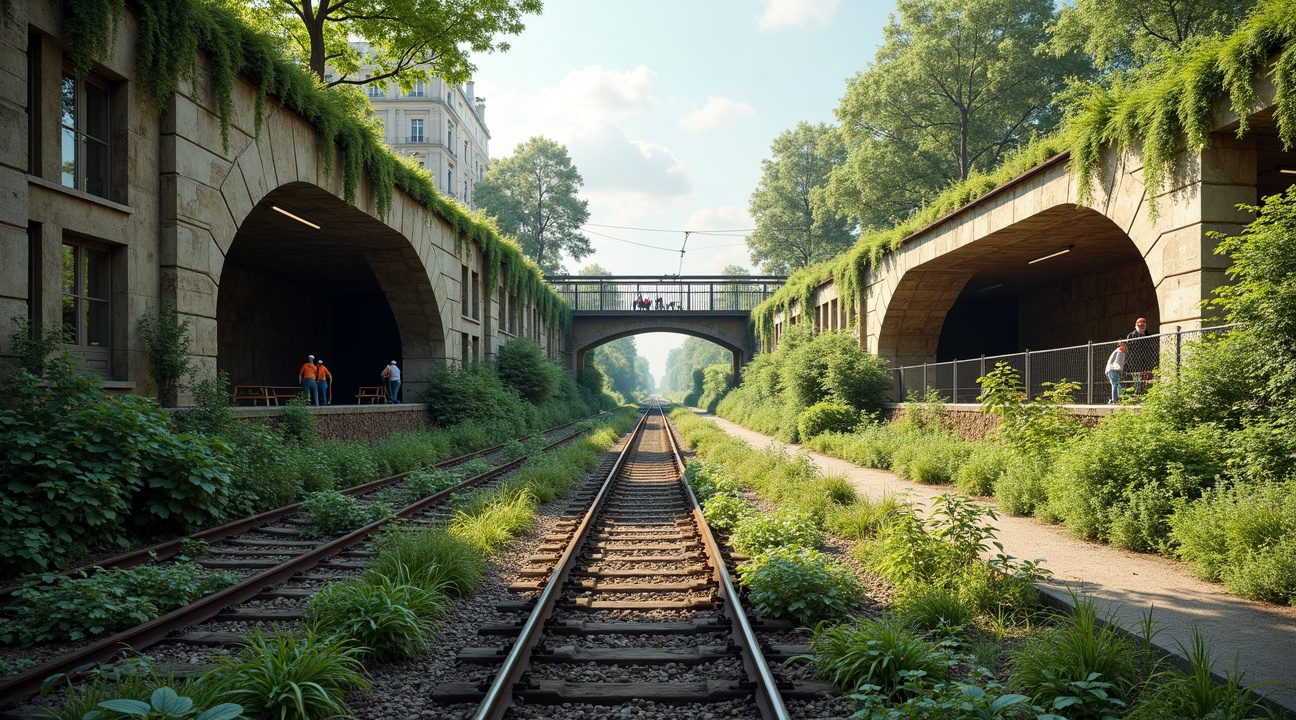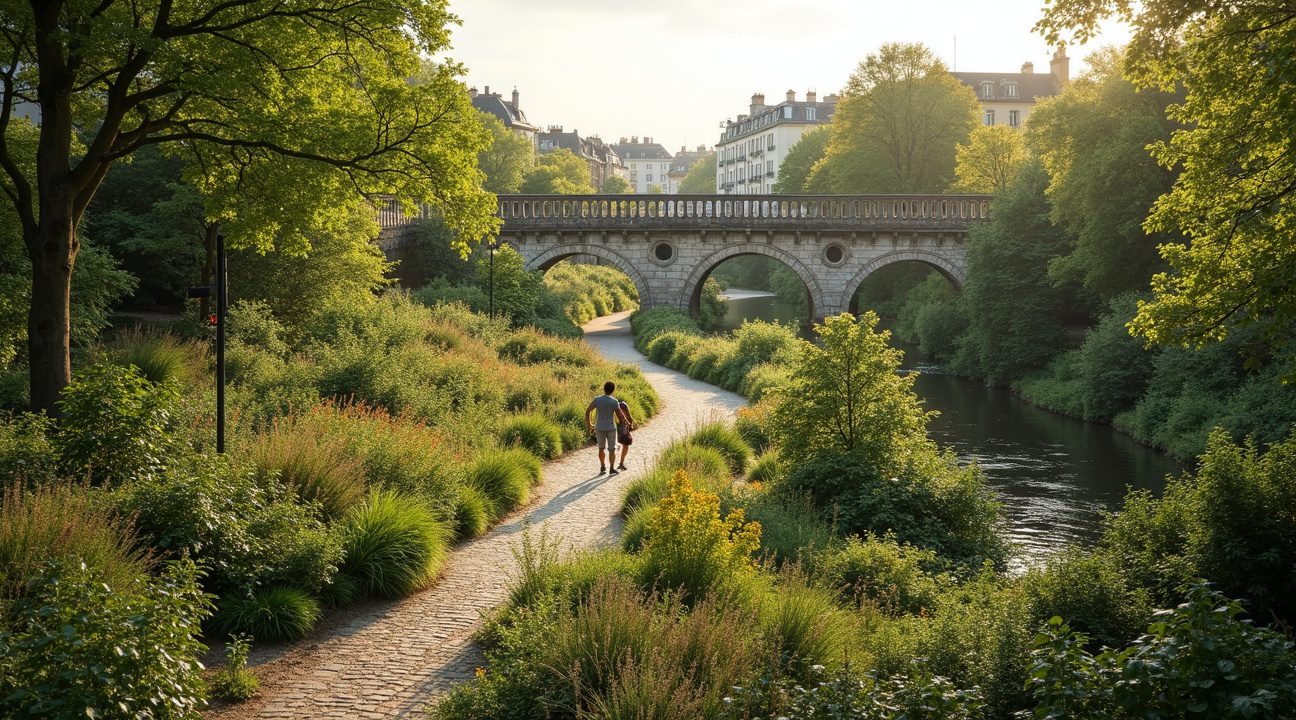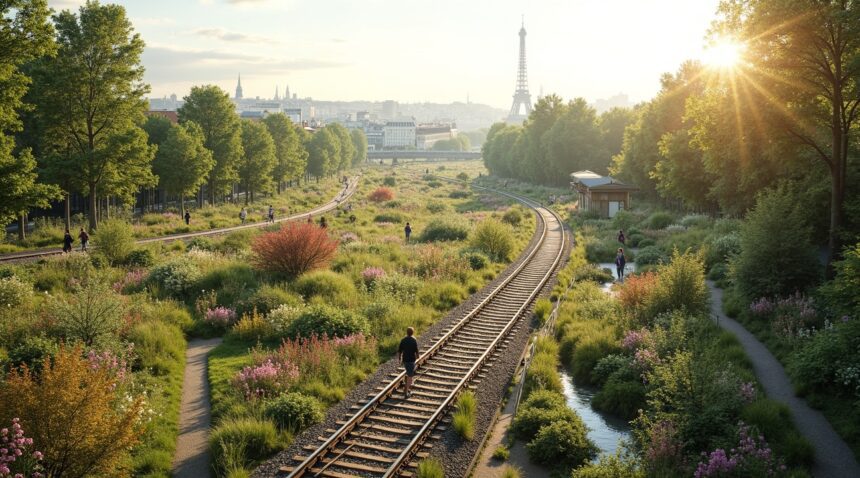Paris has successfully converted roughly 10 kilometers of its historic 32-kilometer Petite Ceinture railway into flourishing urban parks, community gardens, and biodiversity corridors that now span eight arrondissements.
This ambitious conversion project has created the city’s largest continuous ecosystem while demonstrating how abandoned industrial infrastructure can address modern environmental challenges and strengthen community connections.
Key Takeaways
- Massive Scale Impact: The converted railway sections now serve tens of thousands of visitors annually and support hundreds of plant and animal species, creating crucial habitat connectivity through dense urban areas.
- Multi-Functional Design: The transformed spaces integrate recreation, urban farming, stormwater management, air quality improvement, and carbon sequestration while preserving historical railway elements.
- Community-Driven Success: Local associations actively manage urban farm projects and community gardens, creating collaborative stewardship that strengthens neighborhood bonds and provides environmental education opportunities.
- Engineering Innovation: Despite technical challenges including costly tunnel renovations and safety upgrades, the project showcases creative solutions like modular drainage systems and specialized growing media adapted to former railway conditions.
- Global Leadership Model: The circular design distinguishes Paris’s approach from linear projects like New York’s High Line, establishing the city as a leader in adaptive infrastructure reuse that other cities worldwide are now emulating.
From Steam Trains to Urban Oases: Paris Transforms 10 Kilometers of Historic Railway into Green Paradise
I’ve witnessed one of the most remarkable urban transformation projects unfold across Paris over the past decade. The city has converted approximately 10 kilometers of the historic 32-kilometer Petite Ceinture railway into stunning linear parks and green corridors, creating what officials proudly call urban forests.
These converted railway sections now stretch across eight arrondissements—the 12th, 13th, 15th, 16th, 17th, 18th, 19th, and 20th districts—breathing new life into previously neglected urban spaces. What once carried steam trains through the capital now serves as accessible walking paths, recreational areas, and thriving biodiversity reserves that welcome both residents and visitors.
The transformation represents far more than simple beautification. The Petite Ceinture has become Paris’s largest continuous ecosystem, supporting hundreds of plant and animal species within the urban environment. This ecological corridor provides crucial habitat connectivity that allows wildlife to move through the city while offering Parisians direct contact with nature in their daily lives.
Massive Public Response and Environmental Impact
The success of these green spaces speaks volumes through visitor numbers alone. Each year, tens of thousands of people explore these converted railway sections, using them for recreation, exercise, and quiet contemplation. Families stroll along former track beds where wildflowers now bloom, while joggers follow paths that once guided freight trains through the city.
Beyond recreation, these urban forests contribute significantly to Paris’s climate goals and sustainability initiatives. The increased green coverage helps combat the urban heat island effect, providing natural cooling that reduces temperatures in surrounding neighborhoods. Each section of converted railway adds to the city’s carbon sequestration capacity while improving air quality for residents.
The project exemplifies how cities can repurpose industrial infrastructure to address modern environmental challenges. Rather than demolishing the old railway entirely, Paris planners recognized the potential to create something entirely new while preserving the historical footprint of the Petite Ceinture.
These greenways also demonstrate the power of accessible public space design. The linear format of the former railway naturally creates pedestrian-friendly corridors that connect different neighborhoods, encouraging walking and cycling while reducing dependence on motorized transportation. Visitors can experience the Paris Olympics spirit of innovation that extends beyond major sporting events into everyday urban living.
The ongoing transformation continues to evolve, with city planners regularly assessing which additional sections of the remaining 22 kilometers might benefit from similar conversion. Each new segment adds to Paris’s growing network of urban green spaces, reinforcing the city’s commitment to sustainable development and quality of life for its residents.
The Rise and Fall of Paris’s Circular Railway Marvel
I find the story of the Petite Ceinture fascinating—a testament to how urban infrastructure can transform from essential lifeline to forgotten relic. This circular railway line emerged during one of Paris’s most ambitious periods of urban development, creating a transportation network that would define the city’s character for decades.
The Golden Age of Circular Transport
Between 1852 and 1869, engineers constructed this remarkable 32-kilometer circular railway to revolutionize how Paris moved goods and people. The Petite Ceinture connected major railway stations around the city’s perimeter, initially serving as a crucial supply line for the fortification walls that once protected the capital. During the Second Empire period, this infrastructure project represented cutting-edge urban planning.
Steam-powered passenger trains transformed daily life for Parisians as the line reached its operational peak. I’m struck by how efficiently the system operated—six trains per hour ran in both directions, creating a reliable transit option that connected neighborhoods previously isolated from each other. The railway became deeply woven into Parisian urban life, providing both practical transportation and economic opportunities for communities along its route.
The Inevitable Decline
Everything changed when the Paris Metro opened in 1900. Underground rapid transit offered advantages the surface railway couldn’t match—weather protection, reduced travel times, and direct access to the city center. The Metro’s expansion gradually drew passengers away from the circular line, creating a slow but irreversible decline.
Passenger service ended completely in 1934, marking the end of an era for this once-vital transportation link. Freight operations continued for several more decades, but even these dwindled as trucks and other transportation methods proved more flexible and cost-effective. By the 1990s, freight traffic had virtually disappeared from most sections of the line.
Today’s reality tells a complex story of partial abandonment and continued use. Only about 3.5 kilometers of the original Petite Ceinture and the connected Auteuil line remain completely closed to rail traffic. The remaining sections still function as part of France’s national railway network, though their role has shifted dramatically from their original purpose.
The transformation reflects broader changes in urban transportation philosophy. Modern cities prioritize underground systems and road networks over surface railways that consume valuable urban space. Yet the abandoned sections of the Petite Ceinture haven’t simply disappeared—they’ve evolved into something entirely different.
These forgotten railway corridors now offer unique opportunities for urban regeneration. Paris continues innovating with creative approaches to repurposing infrastructure, and the Petite Ceinture represents one of the most intriguing examples.
The railway’s decline wasn’t sudden catastrophe but gradual obsolescence—a reminder that even the most impressive infrastructure can become outdated as cities evolve. What makes the Petite Ceinture special isn’t just its historical significance, but how its abandoned sections are finding new life as green spaces and community gardens.
I see this transformation as representative of broader urban trends across Europe, where cities are increasingly converting former industrial sites into public amenities. The circular railway that once carried coal and passengers now provides corridors for biodiversity and community engagement, proving that infrastructure can have multiple lives across different eras.
Urban Farms Bloom Where Locomotives Once Roomed
I find it fascinating how Paris has transformed select sections of the Petite Ceinture into thriving urban agriculture hubs that serve the local community. These former railway corridors now host community gardens and farms that supply fresh, locally grown produce directly to Parisians. The transformation represents a brilliant example of urban upcycling, where historical infrastructure finds new purpose in supporting modern sustainability goals.
Local associations and residents actively manage these urban farm projects, creating a collaborative approach that strengthens community bonds while providing environmental education opportunities. This partnership model ensures that each site reflects the specific needs and character of its neighborhood. I’ve observed how this cooperative management style has led to innovative growing techniques and diverse crop selections that might not emerge from top-down planning alone.
Agricultural Innovation Takes Root
The agricultural projects sprouting across these converted railway sections include several innovative features that maximize both productivity and ecological benefits:
- Urban beehives that support local pollinator populations while producing honey for the community
- Flower meadows that create biodiversity corridors through the urban landscape
- Orchard plantings featuring fruit trees adapted to the Parisian climate
- Vegetable plots that demonstrate intensive growing techniques suitable for small urban spaces
These diverse agricultural elements contribute significantly to Paris’s ambitious urban agriculture initiatives and local food sourcing objectives. Each project serves as a living laboratory where residents can learn sustainable growing practices while participating in food production. The variety of crops and cultivation methods also helps create resilient local food systems that reduce dependence on distant agricultural regions.
Rehabilitated former stations like Gare de Charonne demonstrate another layer of this transformation strategy. These historic structures now function as cultural venues, restaurants, and event spaces that celebrate both railway heritage and contemporary urban life. I appreciate how this approach preserves architectural history while creating vibrant community gathering spaces that complement the agricultural activities happening along the tracks.
The integration of heritage conservation with dynamic urban programming shows how cities can honor their past while adapting to present needs. These converted stations often feature cultural events that bring additional foot traffic and community engagement to the surrounding garden areas. This symbiotic relationship between cultural programming and agricultural education creates multiple entry points for residents to connect with their local food system and railway history simultaneously.
Engineering Challenges and Creative Solutions in Railway Revival
Converting abandoned railway infrastructure into green spaces presents unique technical obstacles that require innovative approaches. The Petite Ceinture project exemplifies how cities can transform derelict transportation corridors while balancing safety concerns with environmental goals.
Overcoming Infrastructure Obstacles
The piecemeal approach to reconnecting railway segments stems from significant engineering challenges that make continuous development impractical. High costs associated with tunnel renovation and safety requirements have forced planners to prioritize isolated segments rather than creating one uninterrupted park system. Approximately one-third of the railway runs through tunnels, each requiring extensive structural assessments and costly modifications to meet modern safety standards.
Engineers face several critical considerations when repurposing these underground sections:
- Structural integrity assessments of century-old tunnel walls and support systems
- Ventilation system installation for public access and plant growth
- Emergency exit planning and accessibility compliance
- Drainage solutions to prevent flooding and water damage
- Lighting systems that support both human safety and plant photosynthesis
Each completed park section showcases varied landscaping techniques adapted to specific site conditions. Urban gardening plots flourish where soil conditions permit, while walking trails wind through areas with established wild vegetation. Picnic areas occupy former station platforms, demonstrating creative reuse of existing infrastructure. This approach has transformed the Petite Ceinture into one of Paris’s largest biodiversity reserves, supporting wildlife corridors through dense urban fabric.
The city’s dual objectives drive design decisions throughout the project. Preserving biodiversity takes precedence in sections where rare plant species have naturally colonized the abandoned tracks. These areas function as ecological corridors, allowing wildlife movement between European urban parks and green spaces that would otherwise remain isolated.
Providing recreational areas presents different engineering requirements. Sections designated for public access need reinforced pathways, safety barriers, and regular maintenance access points. Planners must balance public safety with ecological preservation, often installing boardwalks and viewing platforms that minimize ground disturbance while offering visitors immersive nature experiences.
Continued debate surrounds connecting separate segments and establishing future policies for remaining unused stretches. Some advocacy groups push for comprehensive connectivity, arguing that linked green corridors would maximize ecological benefits. However, engineers point to prohibitive costs and complex ownership issues that complicate large-scale integration efforts.
Technical solutions continue evolving as new segments enter development phases. Recent innovations include:
- Modular drainage systems that adapt to varying tunnel conditions
- Specialized growing media that supports plant establishment on former railway ballast
- Smart irrigation systems that monitor soil moisture across multiple microclimates
The success of completed sections demonstrates how thoughtful engineering can address seemingly insurmountable challenges. Rather than viewing tunnels and elevated sections as obstacles, planners have embraced these features as opportunities for creative design solutions. Underground sections now serve as unique growing environments for shade-tolerant plants, while elevated portions offer dramatic viewpoints across the city.
Safety requirements remain paramount throughout all development phases. Regular structural monitoring ensures public access areas meet stringent safety standards, while emergency response protocols address the unique challenges of underground park spaces. These measures protect both visitors and the investment in biodiversity conservation that makes each segment valuable.
Future expansion depends on balancing ambitious conservation goals with practical engineering constraints. Each new section must undergo thorough feasibility studies that consider soil conditions, structural integrity, and integration with existing infrastructure. This methodical approach ensures sustainable development while preserving the ecological integrity that makes the Petite Ceinture a model for urban railway conversion projects worldwide.

Paris Joins Global Movement: From High Line to Petite Ceinture
Paris’s transformation of its abandoned railway lines reflects a worldwide trend that’s reshaping urban landscapes. The city’s approach to converting the historic Petite Ceinture mirrors successful projects like New York’s High Line and Seoul’s Seoullo 7017, yet maintains its own distinctive character that sets it apart from international counterparts.
A Circular Vision Unlike Any Other
The Petite Ceinture stands out among global railway park conversions due to its impressive circular design that once encircled the entire city. Originally spanning 32 km and constructed between 1852 and 1869, this railway network represented one of Europe’s most ambitious transportation projects of its era. Currently, about 10 km of the original track have been opened to the public as green spaces, with expansion efforts accelerating significantly after 2013.
This ongoing transformation differs from linear projects like the High Line because it creates a ring of biodiversity that connects diverse neighborhoods throughout Paris. The project’s scale allows for varied ecological approaches, from urban farming initiatives to native plant restoration areas that support local wildlife corridors.
The conversion process emphasizes a dual legacy approach that honors both transportation heritage and ecological innovation. Preserved railway elements, including original bridges and station remnants, serve as historical markers while new plantings and walking paths create spaces for community gathering and environmental education.
Since 2013, expansion efforts have focused on opening new sections systematically, with each phase designed to maximize green urban infrastructure potential. These developments contribute significantly to Paris biodiversity goals while addressing urban sustainability challenges through innovative design solutions.
The project’s success demonstrates how cities can reimagine abandoned infrastructure as assets rather than burdens. Unlike other international examples that primarily serve recreational purposes, the Petite Ceinture integrates multiple functions including:
- Stormwater management
- Air quality improvement
- Food production through community gardens and urban farms
Comparing this transformation to global counterparts reveals Paris’s commitment to creating comprehensive ecological networks rather than isolated green spaces. The circular nature of the original railway allows for continuous habitat connections that support both human recreation and wildlife movement patterns throughout the urban environment.
This approach has established Paris as a leader in adaptive infrastructure reuse, proving that thoughtful planning can transform industrial heritage into vital community resources. The ongoing expansion continues to build on lessons learned from international projects while addressing specifically Parisian urban challenges and opportunities.

Community Impact and Future Vision for Paris’s Green Ring
Converting the abandoned Petite Ceinture railway into green spaces has created remarkable opportunities for community building while addressing significant urban challenges. I’ve observed how these transformed areas now serve as vital gathering spots where residents connect through organized events, volunteer gardening sessions, and educational workshops. Local associations have become essential partners in managing these spaces, bringing neighbors together to maintain community gardens and participate in environmental stewardship programs.
Health Benefits and Environmental Education
The health benefits extend far beyond physical exercise opportunities. These green corridors provide mental wellness spaces in previously dense urban areas where residents had limited access to nature. Community health programs now utilize these parks for outdoor fitness classes and stress-reduction activities. Environmental education initiatives have flourished, with schools and community groups hosting workshops on urban biodiversity, sustainable gardening practices, and climate adaptation strategies.
Physical challenges remain substantial throughout the conversion process. The high number of tunnels along the original railway requires expensive safety upgrades before public access becomes possible. Engineers must install proper lighting, ventilation systems, and emergency exits while preserving the historical character of these underground passages. Despite these costs, the investment pays dividends through improved air quality and reduced urban heat island effects in surrounding neighborhoods.
The transformation supports Paris’s ambitious sustainability agenda by creating carbon-absorbing green infrastructure and promoting local food production through urban farming initiatives. These projects demonstrate how cities can repurpose existing infrastructure for climate resilience rather than building new developments. Biodiversity has increased dramatically in areas where native plants have been reintroduced, creating habitat corridors for urban wildlife.
Future Expansion and Technical Considerations
Future expansion plans focus on developing the remaining unused stretches of the Petite Ceinture into accessible public spaces. City planners are working with community groups to identify priority segments that would provide the greatest benefit to underserved neighborhoods. The Paris Olympics legacy has influenced these plans, emphasizing sustainable urban development as a model for other cities worldwide.
Technical considerations for future phases include improving accessibility for people with mobility challenges and creating seamless connections between existing green sections. Planners are exploring innovative solutions like elevated walkways and gentle-grade access ramps to overcome the railway’s original elevation changes. Smart irrigation systems and renewable energy installations will reduce maintenance costs while supporting the city’s carbon neutrality goals.
Community Engagement and Economic Development
Community engagement continues to drive the project’s success through resident-led initiatives and collaborative decision-making processes. Local associations now manage specific sections, organizing seasonal festivals, art installations, and cultural events that celebrate both the railway’s industrial heritage and its ecological transformation. These partnerships ensure long-term stewardship while reducing municipal maintenance burdens.
The economic impact has exceeded initial projections, with property values increasing in neighborhoods adjacent to completed green sections. Small businesses have emerged to serve park visitors, creating employment opportunities and strengthening local economies. Food production from urban farms supplements community nutrition programs while teaching residents about sustainable agriculture practices.
Education, Safety, and Knowledge Sharing
Educational programs have evolved to include climate science workshops, urban planning seminars, and hands-on conservation projects. Students from local schools participate in habitat restoration activities and learn about ecosystem services through direct observation. These experiences create environmental awareness that extends beyond park boundaries into daily life choices.
Safety improvements have transformed previously neglected areas into well-lit, actively monitored public spaces. Community policing initiatives and volunteer park ambassadors maintain security while fostering positive relationships between residents and local authorities. Emergency response protocols have been established for all accessible sections, ensuring public safety without compromising the natural atmosphere.
The project’s success has inspired similar initiatives in other French cities and internationally. Technical expertise developed during the Petite Ceinture conversion is now being shared through professional networks and urban planning conferences. This knowledge transfer multiplies the project’s impact beyond Paris while establishing the city as a leader in sustainable urban transformation.
Transportation and Connectivity
Integration with existing transportation networks has created new mobility options for residents. Bike paths connecting to the city’s cycling infrastructure encourage sustainable transportation choices while providing recreational opportunities. These connections strengthen the overall green network that makes Paris increasingly livable and environmentally conscious.
https://www.youtube.com/watch?v=UVXzZ0p63RM
Sources:
Wikipedia – Chemin de fer de Petite Ceinture
Worldinparis.com – La Petite Ceinture Paris’ Abandoned Railway
Apur.org – 32 kilometres, the length of the Little Ring Railway
Bonjour Paris – The Petite Ceinture: A 2025 Update
Archives.petiteceinture.org – Current status of the Petite Ceinture circular railway of Paris


